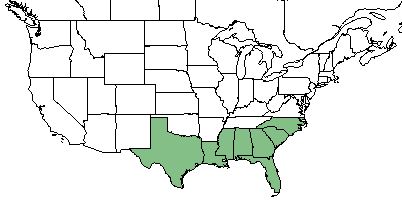Difference between revisions of "Anthaenantia villosa"
(→Ecology) |
(→Seed dispersal) |
||
| Line 42: | Line 42: | ||
===Seed dispersal=== | ===Seed dispersal=== | ||
| − | ''A. villosa'' is wind-pollinated instead of reliant on insects or other animals for pollination. <ref name= "Brudvig"> [Brudvig, L. A., et al. (2015). "The influence of habitat fragmentation on multiple plant-animal interactions and plant reproduction." Ecology 96(10): 2669-2678]</ref> | + | ''A. villosa'' is wind-pollinated instead of reliant on insects or other animals for pollination. <ref name= "Brudvig"> [Brudvig, L. A., et al. (2015). "The influence of habitat fragmentation on multiple plant-animal interactions and plant reproduction." Ecology 96(10): 2669-2678]</ref> This species is thought to be dispersed by gravity. <ref> Kirkman, L. Katherine. Unpublished database of seed dispersal mode of plants found in Coastal Plain longleaf pine-grasslands of the Jones Ecological Research Center, Georgia.</ref> |
<!--===Seed bank and germination===--> | <!--===Seed bank and germination===--> | ||
<!--===Fire ecology===--> <!--Fire tolerance, fire dependence, adaptive fire responses--> | <!--===Fire ecology===--> <!--Fire tolerance, fire dependence, adaptive fire responses--> | ||
| − | <!--===Pollination===--> | + | <!--===Pollination===--> |
| + | |||
===Use by animals=== | ===Use by animals=== | ||
''A. villosa'' is a bunchgrass that is used by herbivorous animals. <ref name= "Brudvig"> [Brudvig, L. A., et al. (2015). "The influence of habitat fragmentation on multiple plant-animal interactions and plant reproduction." Ecology 96(10): 2669-2678]</ref> | ''A. villosa'' is a bunchgrass that is used by herbivorous animals. <ref name= "Brudvig"> [Brudvig, L. A., et al. (2015). "The influence of habitat fragmentation on multiple plant-animal interactions and plant reproduction." Ecology 96(10): 2669-2678]</ref> | ||
Revision as of 14:37, 28 August 2018
Common Names: Green silkyscale
| Anthaenantia villosa | |
|---|---|
| Scientific classification | |
| Kingdom: | Plantae |
| Division: | Magnoliophyta - Flowering plants |
| Class: | Liliopsida - Monocots |
| Order: | Cyperales |
| Family: | Poaceae |
| Genus: | Anthaenantia |
| Species: | A. villosa |
| Binomial name | |
| Anthaenantia villosa (Michaux) P. Beauv. | |

| |
| Natural range of Anthaenantia villosa from USDA NRCS Plants Database. | |
Contents
Taxonomic Notes
Synonyms: Antenantia villosa (Kral)
Variety: none
Description
A. villosa is a perennial graminoid in the Poaceae family native to the southeastern United States. [1]
Distribution
A. villosa can be found in a number of southeastern states including Florida, Georgia, Alabama, South Carolina, North Carolina, Louisiana, Mississippi, and Texas. [1]
Ecology
Habitat
A. villosa is found in long-leaf pine regions. This grass excels in more exculsively long-leaf pine regions during times of higher levels of needle fall from the canopy. [2]
Mild competition is beneficial to viable seed production for A. villosa, making the species more likely to thrive in a variety of competitive environments. [3]
Habitats that specimens of A. villosa have been recovered from include dry sandy edges of coastal flatwoods, sandy peat of flatwoods, turkey oak sand ridge, open live hammock, savanna, edge of longleaf pinelands, grassy roadside with pine overstory, and mixed woodland [4]
Seed dispersal
A. villosa is wind-pollinated instead of reliant on insects or other animals for pollination. [2] This species is thought to be dispersed by gravity. [5]
Use by animals
A. villosa is a bunchgrass that is used by herbivorous animals. [2]
Conservation and Management
Cultivation and restoration
Photo Gallery
References and notes
- ↑ 1.0 1.1 USDA Plant Database
- ↑ 2.0 2.1 2.2 [Brudvig, L. A., et al. (2015). "The influence of habitat fragmentation on multiple plant-animal interactions and plant reproduction." Ecology 96(10): 2669-2678]
- ↑ [Dagley, C. M., et al. (2002). "Understory restoration in longleaf pine plantations: Overstory effects of competition and needlefall." Proceedings of the eleventh biennial southern silvicultural research conference.]
- ↑ URL: http://herbarium.bio.fsu.edu. Last accessed: June 2018. Collectors: Loran C. Anderson, Gil Nelson, R.K. Godfrey, R. Kral, D. L. Martin, S. T. Cooper, Frank Tomkow, Richard D. Houk, J. B. Morrill, A. H. Curtiss, A. Gholson Jr., Angus Gholson, James D. Ray, Jr., O. Lakela, Gary R. Knight, Cecil R Slaughter, Helen Roth, M. Darst, L. Reed. States and counties: Florida (Wakulla, Okaloosa, Levy, Liberty, Madison, Marion, Pasco, Putnam, Santa Rosa, Calhoun, Duval, Franklin, Gadsden, Hernando, Hillsborough, Jackson, Jefferson, Leon) Georgia (Baker)
- ↑ Kirkman, L. Katherine. Unpublished database of seed dispersal mode of plants found in Coastal Plain longleaf pine-grasslands of the Jones Ecological Research Center, Georgia.